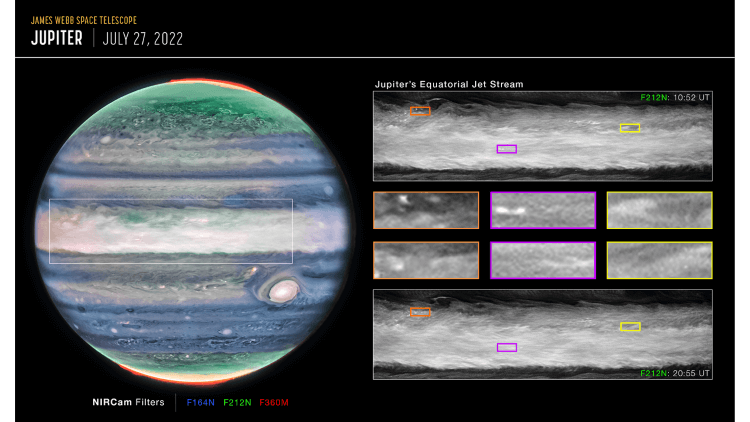
Image of Jupiter taken by NASA’s James Webb Space Telescope’s NIRCam (Near-Infrared Camera) in July 2022 displays striking features of the largest planet in the solar system in infrared light, with brightness indicating high altitudes. One of these features is a jet stream within the large bright band just above Jupiter’s equator, which was the focus of this study.
POSTED ONOCTOBER 20, 2023 BY LAURENCE TOGNETTI
In July 2022, NASA’s James Webb Space Telescope (JWST) used its NIRCam (Near-Infrared Camera) to capture stunning infrared images of the largest planet in the solar system, Jupiter. Within these striking images, scientists recently discovered a jet stream in the northern latitudes just over Jupiter’s equator and 20-35 kilometers (12-21 miles) above Jupiter’s cloud tops. This jet stream stretches approximately 4,800 kilometers (3,000 miles) with speeds of 515 kilometers per hour (320 miles per hour), more than double the speed of a Category 5 hurricane on Earth.
“This is something that totally surprised us,” said Dr. Ricardo Hueso, who is a lecturer at the University of the Basque Country in Spain and lead author of the study published in Nature Astronomy that describes these incredible findings. “What we have always seen as blurred hazes in Jupiter’s atmosphere now appear as crisp features that we can track along with the planet’s fast rotation.”
The reason this jet stream is traveling so fast is due to the Coriolis effect, as all planetary bodies spin faster at their equator to cover the same amount of distance as everything else. However, while the Earth spins on its axis at approximately 1,600 kilometers per hour (1,000 miles per hour) at its equator, the speeds experienced at Jupiter’s equator are a mind-bending 43,000 kilometers per hour (28,273 miles per hour), resulting in not only a rotation at 9 hours and 50 minutes at the equator (9 hours and 56 minutes at the poles), but also result in the extremely fast and powerful wind storms within its massive clouds.

This image of Jupiter from NASA’s James Webb Space Telescope’s NIRCam (Near-Infrared Camera) in July 2022 shows a narrow jet stream traveling 320 miles per hour (515 kilometers per hour) sitting over Jupiter’s equator above the main cloud decks, which was the focus of this study. Scientists hypothesize the multitude of bright white ‘spots’ and ‘streaks’ are possibly very high-altitude cloud tops of comprised of condensed convective storms.
While JWST made its observations within Jupiter’s high altitudes, the team used NASA’s Hubble Space Telescope to make observations in lower altitudes just one day later, which helped the team estimate changes in wind speeds with respective to altitude within the clouds, also known as wind shears. While they found the jet stream of 515 kilometers per hour (320 miles per hour) higher in the clouds, these wind speeds decreased as the altitude decreased, with speeds of 362 kilometers per hour (225 miles per hour) and 402 kilometers per hour (250 miles per hour) occurring only a few miles lower in Jupiter’s massive atmosphere. Essentially, the team of astronomers briefly played the role of meteorologists as they analyzed and calculated Jupiter’s weather patterns.
“Jupiter has a complicated but repeatable pattern of winds and temperatures in its equatorial stratosphere, high above the winds in the clouds and hazes measured at these wavelengths,” said Dr. Leigh Fletcher, who is a Professor of Planetary Science at the University of Leicester and one of several co-authors on the study. “If the strength of this new jet is connected to this oscillating stratospheric pattern, we might expect the jet to vary considerably over the next 2 to 4 years – it’ll be really exciting to test this theory in the years to come.”
This is not the first time that scientists have observed jet streams on Jupiter, as NASA’s Cassini spacecraft observed such activity in the early 2010s. These jet streams were also observed just above the gas giant’s equator and estimated to be traveling at 523 kilometers per hour (325 miles per hour).
Along with this jet stream, these incredible images from July 2022 also revealed Jupiter’s faint rings, its northern and southern aurorae, and two of its smaller moons, Amalthea and Adrastea. Jupiter’s rings were discovered by NASA’s Voyager 1 spacecraft in 1979 as it flew past the gas giant, and scientists hypothesize they were formed from meteoroids striking one of Jupiter’s small moons. Like Earth, Jupiter’s massive aurorae are produced from its even more massive magnetic field, which is 20,000 times stronger than Earth’s magnetic field. The two small moons, Amalthea and Adrastea, were discovered in 1892 and 1979, respectively, with both orbiting within the orbit of Io, the first Galilean Moon of Jupiter.
What new discoveries will JWST continue to make about Jupiter and its amazing features in the coming years and decades? Only time will tell, and this is why we science!
As always, keep doing science & keep looking up!
PHOTOS Credit: NASA, ESA, CSA, STScI, R. Hueso (University of the Basque Country), I. de Pater (University of California, Berkeley), T. Fouchet (Observatory of Paris), L. Fletcher (University of Leicester), M. Wong (University of California, Berkeley), J. DePasquale (STScI))
No comments:
Post a Comment